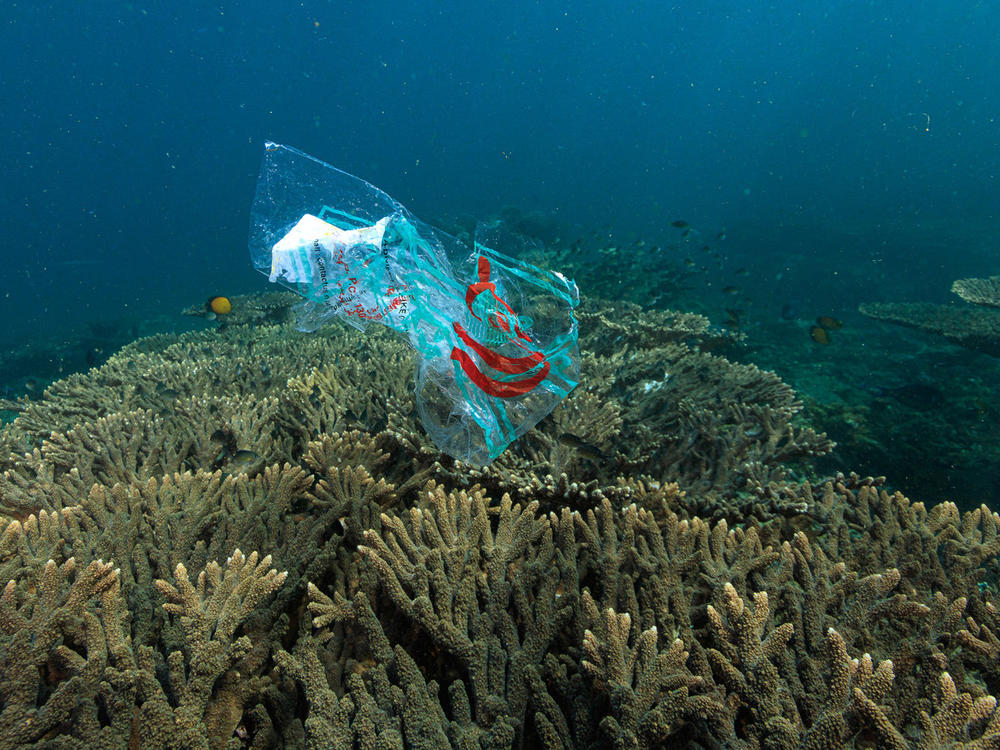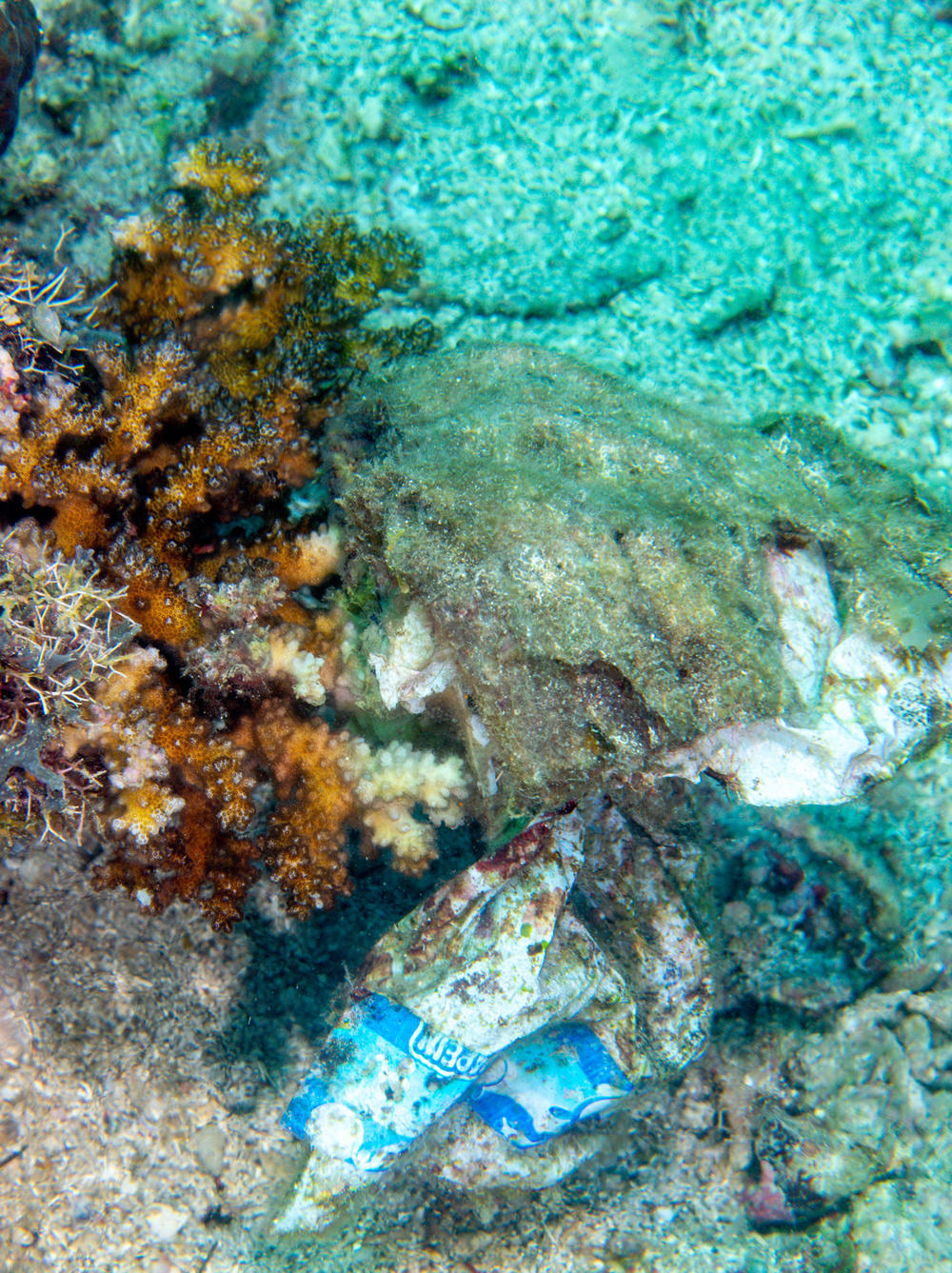Section Branding
Header Content
Plastic is suffocating coral reefs — and it's not just bottles and bags
Primary Content
Finding new species of fish was the goal when marine biologist Hudson Pinheiro was diving in the Verde Island Passage in the Philippines. And he found them. But while he was down there, he found something else that was deeply troubling: plastic — loads of it smothering the coral reef where the fish were living.
"It's sad," Pinheiro, currently a researcher with the University of São Paulo, told NPR. "It's super, super sad."
Pinheiro expanded his research focus beyond fish to the plastics they live with. Of particular interest to him: The kinds of plastics covering the reefs and how they were impacting the health of the corals and their fish communities.
Researchers have previously found that plastic can not only "suffocate and kill the corals, sponges and other invertebrates," says Pinheiro, but also increase the likelihood of a coral getting a disease by 20 times, according to a 2018 study published in Science.
Over the next several years, Pinheiro and 18 other researchers examined trash from 84 reefs across the Atlantic, Pacific and Indian Oceans — often spending 5 to 6 hours per dive. In harder to reach locations, the team used video recorders mounted on underwater vehicles.
The result was what Pinheiro calls the most comprehensive catalog to date of the acres of plastic debris impacting corals. His team found that it sits atop 92% of the reefs they studied, including some of the most remote and uninhabited ones. His study appears in this week's issue of Nature.
More than bags and bottles
What Pinheiro and his team found was that the trash wasn't just plastic bags and bottles. The lion's share was actually plastic fishing debris, "like ropes, long lines, nets that get entangled and get stuck in the reef," he says.
Even after all this fishing gear settles on the coral, it keeps on killing other marine animals. It continues to catch fish even after it's been discarded or lost – a phenomenon known as "ghost fishing."
The researchers were also surprised to discover there was more plastic enmeshed in deeper reefs than shallower ones.
That may be because "most of the fish are already overfished in the shallow water," says Pinheiro. "So the fishermen [are] moving to deeper reefs to catch the same amount that they used to catch before."
Plastic pollution was denser on reefs near cities and markets, which is logical. More people equals more plastic waste. But there was also a great deal of plastic found in marine protected areas, underwater regions intended for long-term conservation, where you would think people would be more careful about littering. That was curious at first, says Pinheiro, but made sense when he considered that's where fish (and therefore fishermen) are found in relatively higher abundance.
Where plastic waste on reefs is worse
Pinheiro says that low and middle-income countries (like Brazil, the Philippines, and the East African nation of Comoros) tend to have more plastic pollution due to limited resources allocated to waste management and improving fishing gear. "If you don't take care of collecting and recycling and having a good destination" to dispose of the trash, explains Pinheiro, "it easily [gets into] the environment."
"We need to be thinking about how higher income countries can help lower income countries pay for their solutions," says ecologist Chelsea Rochman who studies plastic pollution at the University of Toronto and wasn't involved in the research.
"It's often been the case that where people look for plastic pollution, people find it," she says. But what makes this study special, says Rochman, is that the authors have counted the plastic in the same way across many locations to show "this global distribution in a way that you can make comparisons, which will be really important for management."
Pinheiro says he's worried by what he and his colleagues found, but he's committed to try to turn things around for the reefs. He says that governments need regulations that reduce single-use plastic and improve trash collection.
And he stresses the importance of working with and supporting communities dependent on fishing. "How can we change the ropes, the nets?," he asks. "We need to find a biodegradable material, like made from fibers as we used to do before."
He points to a couple success stories like the prohibition of single-use plastic bags (in California, for example). In other places like Honduras and the Maldives, says Pinheiro, they're offering incentives to produce biodegradable materials for products like clothing. And he points to Fernando de Noronha, a Brazilian volcanic archipelago that has banned plastic packaging and is encouraging the use of eco-friendly materials.
The overall goal is for all this plastic to stop finding its way to the reefs, he says. And perhaps start cleaning up what's already there.
Next up for Pinheiro: He will expand his work on plastics and fish communities to cover rocky shores and rocky reefs. And he plans to work at the regional level to make policy recommendations to managers and governments.
Copyright 2023 NPR. To see more, visit https://www.npr.org.




